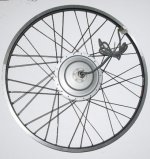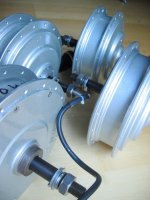cycle9
10 W
Announcement: New high-powered, higher-torque BMC hub motors
We have worked with BMC to develop a new "high-torque" version of their latest high-powered, internally-geared hub motors. This is very similar to the new V2/Thunderbolt/Puma motor (depending on whom you're speaking to, it may be called any of those things), but the new motor, V2-T, has a higher winding count on the stator poles. What does that mean?
This emphasizes torque over speed. That will have two benefits.
- First, for those who have steep hills and/or heavy loads to carry, this new motor will be more efficient for that purpose
- Second, for those who don't need or want their bike to travel at 30 mph @ 36V, this will reduce the top speed to around 22 mph at 36V, and around 28 mph at 48V. For example, this will make it easier to build a bike that complies with some state laws for on-road usage (many states/territories limit top speed to 20mph, though both the law and its enforcement varies widely).
We only have four of these motors on the way initially (to arrive early next week), and two are spoken for. If results are good, we'll get more in mid to late December. BMC is also making them available to other suppliers, though to my knowledge there are only a total of 8 in existence at the moment (someone else will have the other 4). We are building these up in heavy duty wheels using Sun Rhyno Lite and/or Mammoth rims, with double butted 2.3/2.0 Wheelsmith spokes. We're treating the initial shipment as a beta test, and so are looking for a few capable testers. I haven't listed them on our website yet, but will do so in the next week or so. In the meantime, feel free to contact me about it (morgan at cycle9.com). I've attached a few images of some of the BMC motor internals and externals here.
For the technically savvy:
BMC claims the torque will be 38% higher on this motor. But, that really depends on what controller it is paired with, and at what speed the torque is measured. I've been having a great discussion with Justin over at ebikes.ca about what higher winding counts actually mean in terms of real performance (thanks, Justin!). The upshot is that if winding counts are doubled, that does not result in a doubling of torque, due to the motor's inductance. But, as winding count increases, the resistance of the motor is increased, which leads to a more efficient coupling of motor plus controller for lower speed operation. The most efficient case is to have a controller that can produce exactly the amount of current that the motor can accept, without having to go into current-limiting mode. Once we have the new motors in hand in the next few days, we'll measure the resistance and determine the optimal controller pairing from that.
Morgan
http://www.cycle9.com
 View attachment 1
View attachment 1
We have worked with BMC to develop a new "high-torque" version of their latest high-powered, internally-geared hub motors. This is very similar to the new V2/Thunderbolt/Puma motor (depending on whom you're speaking to, it may be called any of those things), but the new motor, V2-T, has a higher winding count on the stator poles. What does that mean?
This emphasizes torque over speed. That will have two benefits.
- First, for those who have steep hills and/or heavy loads to carry, this new motor will be more efficient for that purpose
- Second, for those who don't need or want their bike to travel at 30 mph @ 36V, this will reduce the top speed to around 22 mph at 36V, and around 28 mph at 48V. For example, this will make it easier to build a bike that complies with some state laws for on-road usage (many states/territories limit top speed to 20mph, though both the law and its enforcement varies widely).
We only have four of these motors on the way initially (to arrive early next week), and two are spoken for. If results are good, we'll get more in mid to late December. BMC is also making them available to other suppliers, though to my knowledge there are only a total of 8 in existence at the moment (someone else will have the other 4). We are building these up in heavy duty wheels using Sun Rhyno Lite and/or Mammoth rims, with double butted 2.3/2.0 Wheelsmith spokes. We're treating the initial shipment as a beta test, and so are looking for a few capable testers. I haven't listed them on our website yet, but will do so in the next week or so. In the meantime, feel free to contact me about it (morgan at cycle9.com). I've attached a few images of some of the BMC motor internals and externals here.
For the technically savvy:
BMC claims the torque will be 38% higher on this motor. But, that really depends on what controller it is paired with, and at what speed the torque is measured. I've been having a great discussion with Justin over at ebikes.ca about what higher winding counts actually mean in terms of real performance (thanks, Justin!). The upshot is that if winding counts are doubled, that does not result in a doubling of torque, due to the motor's inductance. But, as winding count increases, the resistance of the motor is increased, which leads to a more efficient coupling of motor plus controller for lower speed operation. The most efficient case is to have a controller that can produce exactly the amount of current that the motor can accept, without having to go into current-limiting mode. Once we have the new motors in hand in the next few days, we'll measure the resistance and determine the optimal controller pairing from that.
Morgan
http://www.cycle9.com
 View attachment 1
View attachment 1

